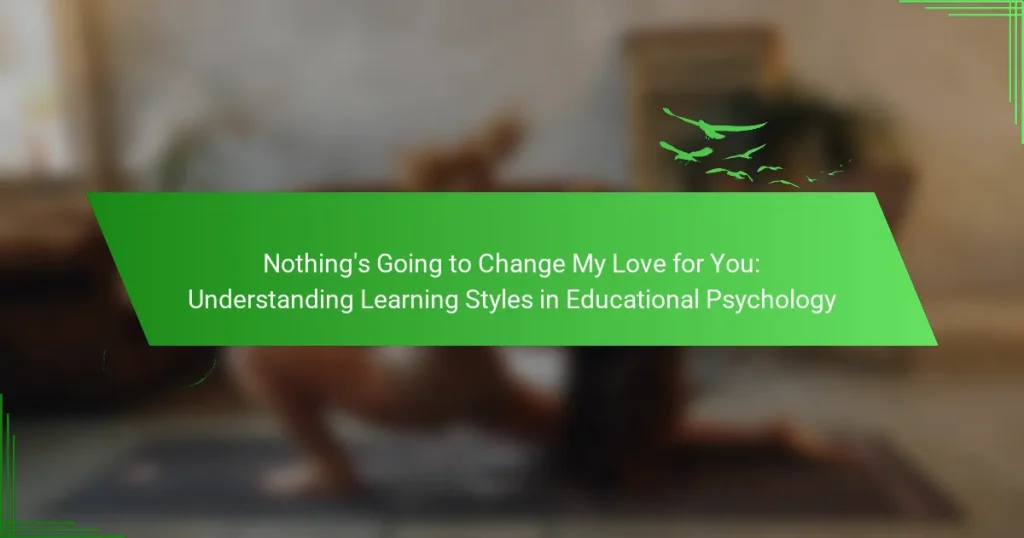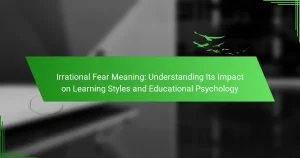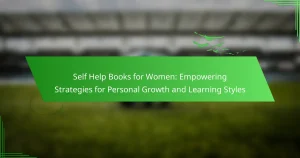Understanding learning styles in educational psychology is crucial for enhancing student engagement and retention. This article explores the three primary learning styles: visual, auditory, and kinesthetic. It examines universal attributes that enhance learning experiences, unique attributes that differentiate learners, and rare attributes that influence engagement. Finally, it discusses effective strategies for educators to tailor their teaching methods to accommodate diverse learning preferences.
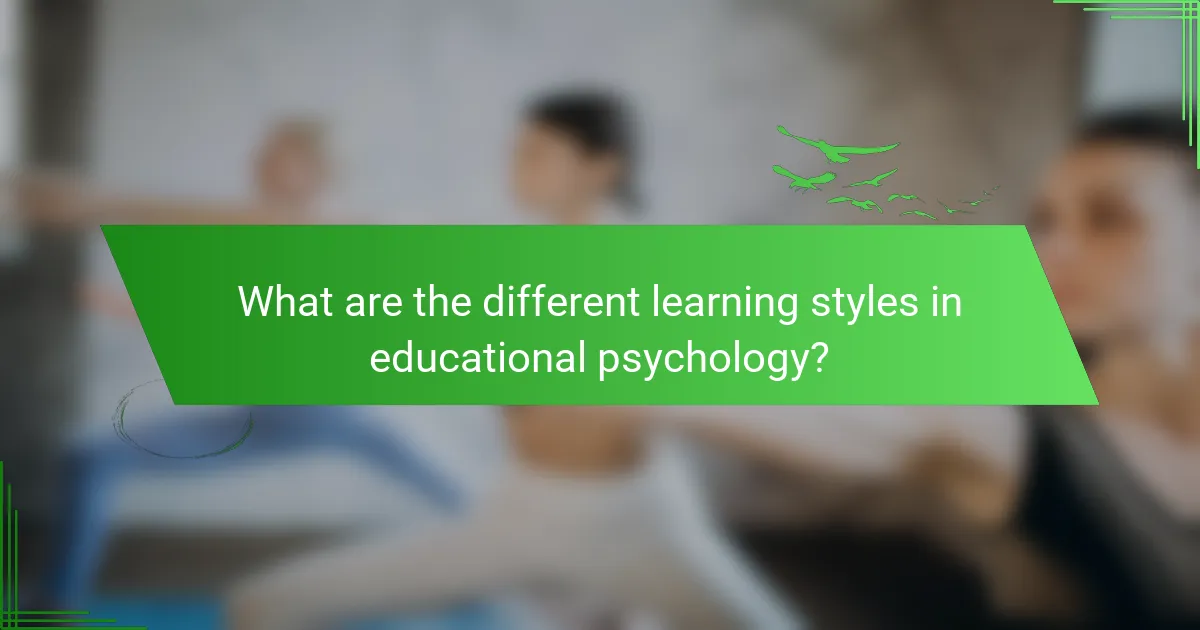
What are the different learning styles in educational psychology?
There are three primary learning styles in educational psychology: visual, auditory, and kinesthetic. Visual learners benefit from diagrams and charts, auditory learners excel with spoken information, and kinesthetic learners grasp concepts through hands-on activities. Understanding these styles enhances teaching strategies and improves student engagement.
How do visual learning styles impact student engagement?
Visual learning styles significantly enhance student engagement by catering to diverse learning preferences. Students who learn visually are more likely to retain information when presented with diagrams, charts, and images. Research indicates that incorporating visual aids can improve comprehension and motivation, leading to a more interactive classroom environment. As a result, educators who adapt their teaching methods to include visual elements can foster a deeper connection with their students, enhancing overall learning outcomes.
What role do auditory learning styles play in information retention?
Auditory learning styles significantly enhance information retention by engaging learners through listening. This method allows for better processing of verbal information, which can lead to improved recall. Studies show that auditory learners often benefit from lectures, discussions, and audio materials, making these formats effective for their learning. Engaging auditory techniques, such as repetition and storytelling, further deepen understanding and memory retention.
How do kinesthetic learning styles enhance practical skills?
Kinesthetic learning styles enhance practical skills by promoting hands-on experiences and active engagement. This approach allows learners to physically manipulate materials and practice tasks, which reinforces memory and understanding. Studies show that kinesthetic learners often excel in environments where they can apply concepts in real-world scenarios. This unique attribute of experiential learning fosters better retention and skill development compared to traditional methods. As a result, kinesthetic learners can effectively translate theoretical knowledge into practical applications.
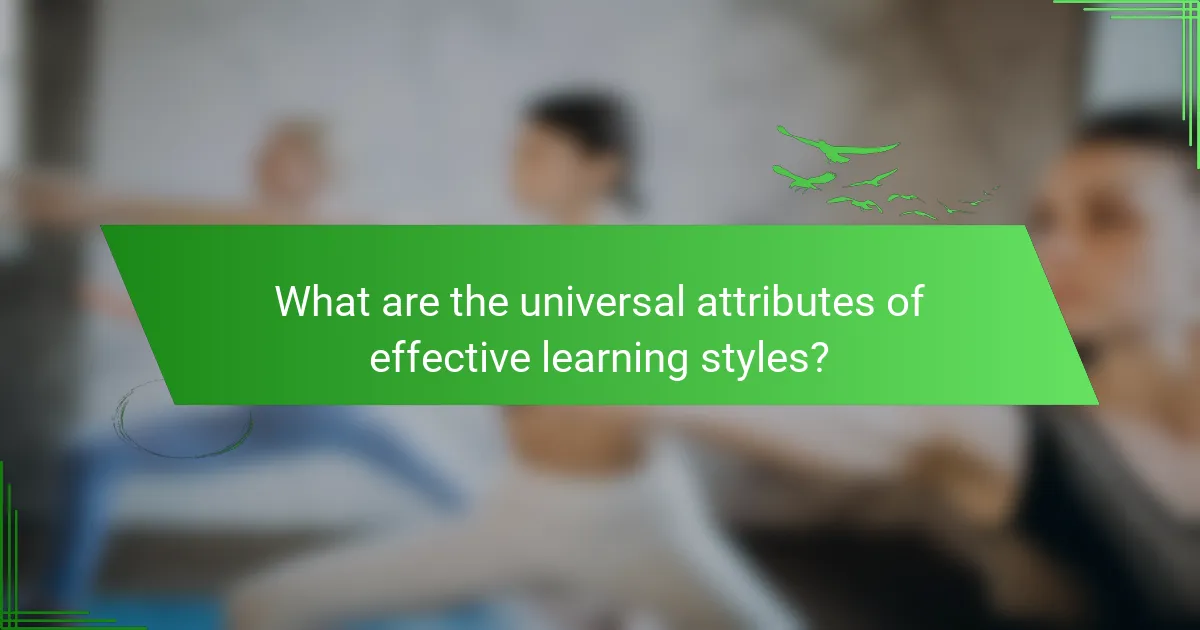
What are the universal attributes of effective learning styles?
Effective learning styles share universal attributes such as adaptability, engagement, and feedback. These attributes enhance the learning experience across diverse educational settings. Adaptability allows learners to adjust their methods to fit various contexts, promoting better understanding. Engagement fosters active participation, leading to improved retention of information. Feedback provides critical insights into progress, enabling learners to refine their approaches effectively.
How do learning styles cater to diverse educational needs?
Learning styles address diverse educational needs by tailoring approaches to individual preferences. This personalization enhances engagement and retention. For instance, visual learners benefit from diagrams, while auditory learners thrive with lectures. Research indicates that adapting teaching methods to these styles can improve academic performance significantly. Understanding these unique attributes ensures that education is inclusive and effective for all students.
What common challenges do educators face with learning styles?
Educators face several common challenges with learning styles, including misconceptions, lack of training, and resource limitations. Misconceptions about learning styles can lead to ineffective teaching strategies. Many educators have not received adequate training on how to implement learning styles effectively in their classrooms. Additionally, resource limitations can hinder the ability to tailor instruction to diverse learning preferences. These challenges can impact student engagement and learning outcomes.
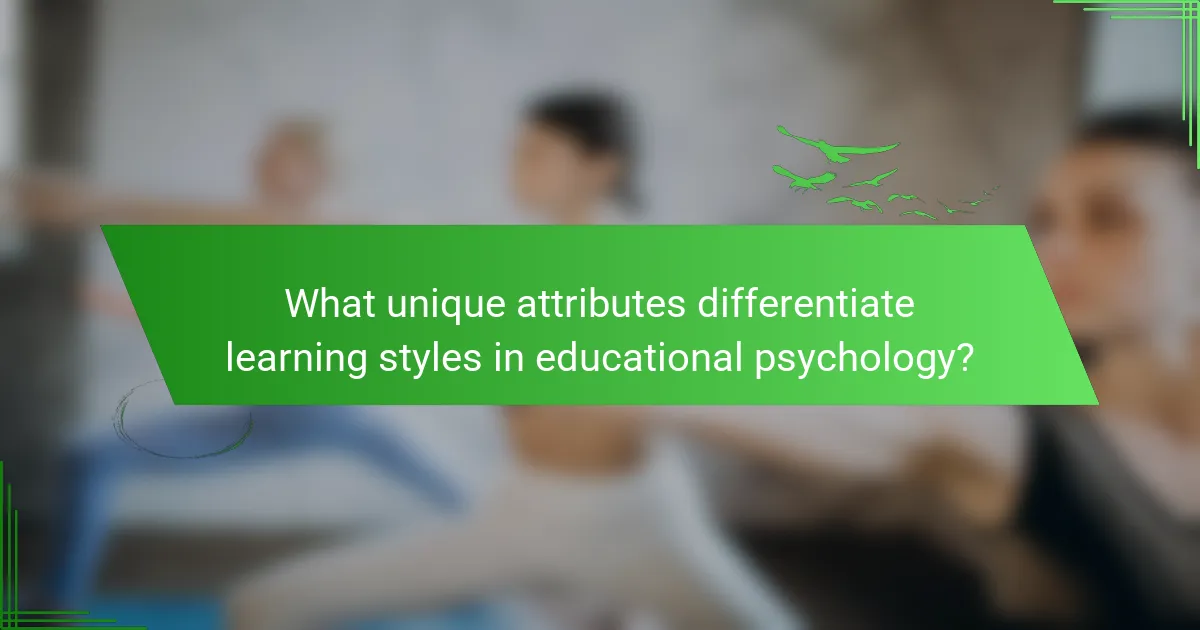
What unique attributes differentiate learning styles in educational psychology?
Learning styles in educational psychology are differentiated by unique attributes such as sensory preferences, cognitive processing, and motivation levels. Sensory preferences include visual, auditory, and kinesthetic modalities, influencing how learners engage with material. Cognitive processing styles, like analytical versus holistic thinking, affect information retention. Motivation levels can vary significantly, impacting a learner’s engagement and persistence. Understanding these unique attributes helps educators tailor their approaches to meet diverse learning needs.
How can personalized learning approaches benefit from understanding learning styles?
Personalized learning approaches benefit significantly from understanding learning styles as they enhance engagement and retention. Recognizing diverse learning preferences allows educators to tailor strategies, improving individual outcomes. For instance, visual learners thrive with diagrams, while auditory learners excel through discussions. This adaptability fosters a supportive learning environment, catering to unique attributes of each student. As a result, personalized learning becomes more effective, addressing the root attribute of engagement and the unique attribute of individual learning preferences.
What innovative teaching methods align with specific learning styles?
Innovative teaching methods include differentiated instruction, project-based learning, and experiential learning. These approaches align with visual, auditory, and kinesthetic learning styles, respectively. For example, project-based learning engages students through hands-on activities, catering to kinesthetic learners. Differentiated instruction allows for tailored content, meeting diverse learning preferences effectively.
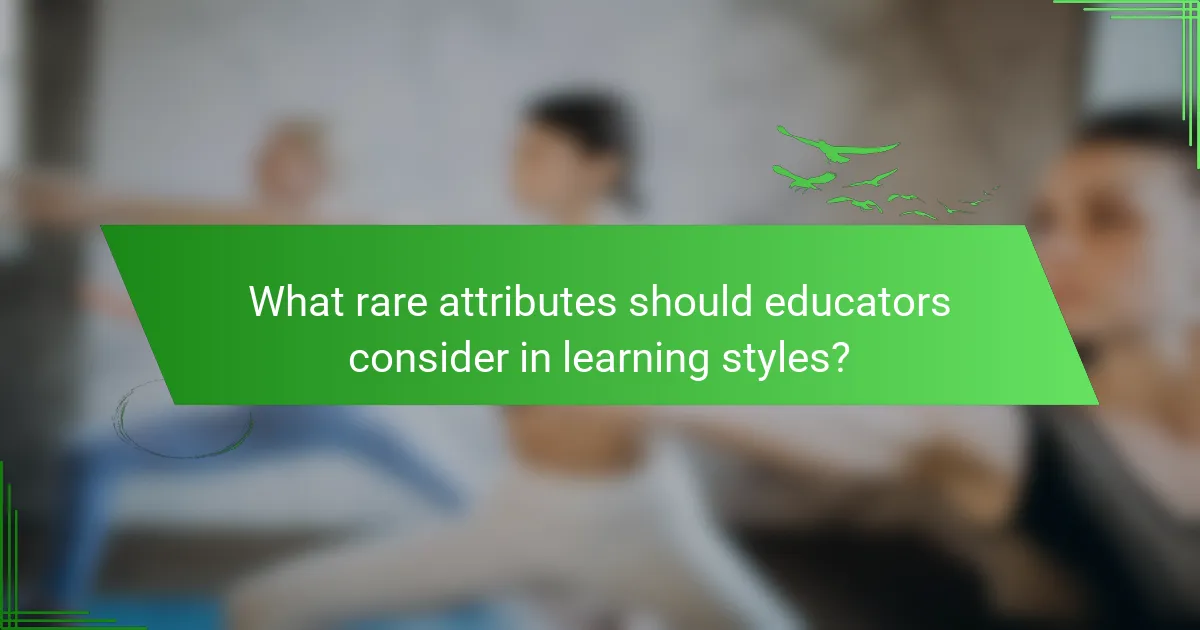
What rare attributes should educators consider in learning styles?
Educators should consider rare attributes like emotional intelligence, cultural background, and sensory preferences in learning styles. These factors significantly influence how students engage with material and retain information. Emotional intelligence affects motivation and social interactions, while cultural background shapes perspectives on learning. Sensory preferences, such as visual or auditory learning, can impact the effectiveness of instructional methods. Understanding these rare attributes allows educators to tailor their approaches, enhancing overall learning outcomes.
How do cultural influences shape learning style preferences?
Cultural influences significantly shape learning style preferences by affecting how individuals process information. Factors such as societal values, communication styles, and educational practices create distinct learning environments. For instance, collectivist cultures may prioritize collaborative learning, while individualistic cultures might emphasize self-directed study. These cultural frameworks impact motivation, engagement, and the effectiveness of various learning strategies. Understanding these influences helps educators tailor approaches to meet diverse student needs.
What emerging trends in educational psychology are affecting learning styles?
Emerging trends in educational psychology are reshaping learning styles by emphasizing personalized and adaptive learning approaches. These trends include the integration of technology, a focus on emotional intelligence, and the recognition of diverse learning environments.
Technology enhances learning through data analytics, allowing educators to tailor instruction to individual needs. Emotional intelligence fosters a supportive atmosphere, improving student engagement and motivation. Recognizing diverse learning environments acknowledges that students thrive in varying contexts, leading to more inclusive educational practices.
These trends collectively highlight a shift towards a more holistic understanding of learning styles, prioritizing adaptability and student-centered approaches.
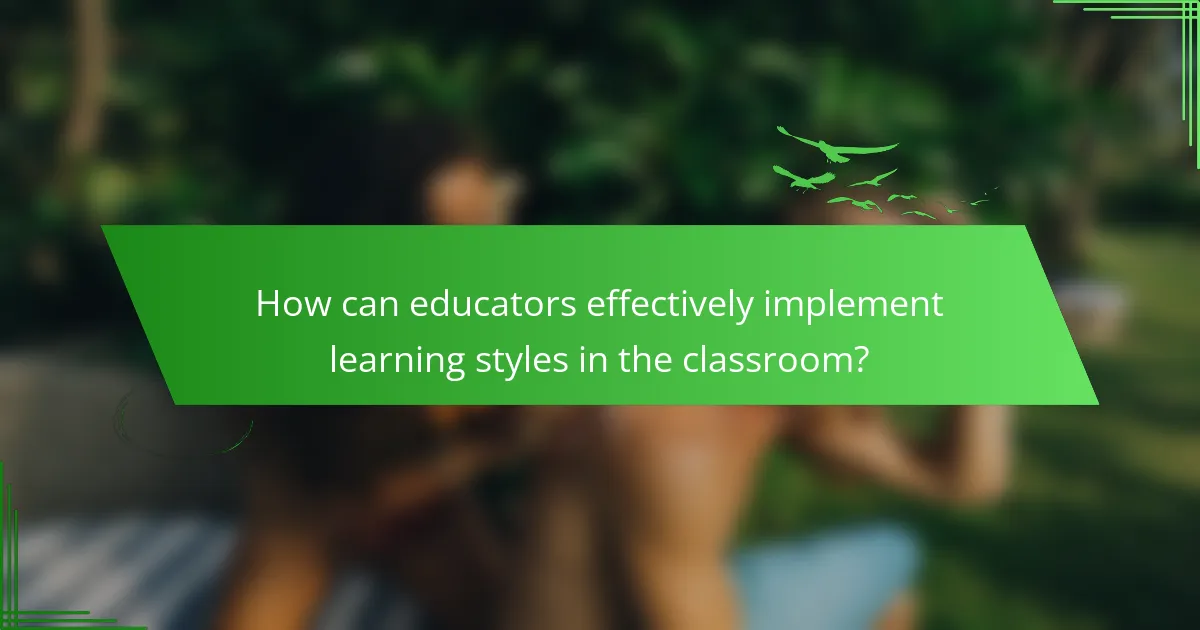
How can educators effectively implement learning styles in the classroom?
Educators can effectively implement learning styles by tailoring their teaching methods to accommodate different preferences. This approach enhances student engagement and retention.
1. Assess learning styles: Use surveys or observations to identify students’ preferred learning modalities, such as visual, auditory, or kinesthetic.
2. Diversify instructional methods: Incorporate a mix of lectures, hands-on activities, and visual aids to address various learning preferences.
3. Create flexible learning environments: Design classrooms that allow for movement and collaboration, facilitating different learning styles.
4. Encourage self-directed learning: Teach students to recognize their learning preferences and empower them to seek resources that align with their styles.
What are best practices for assessing students’ learning styles?
To effectively assess students’ learning styles, educators should employ diverse strategies. Incorporate surveys and questionnaires to gather insights on preferences. Use observational methods to identify engagement levels during different activities. Implement differentiated instruction to cater to various styles, enhancing learning outcomes. Regular feedback sessions can reveal students’ evolving preferences, allowing for timely adjustments.
How can technology support diverse learning styles?
Technology can enhance diverse learning styles by providing tailored educational experiences. Adaptive learning platforms adjust content to individual needs, catering to visual, auditory, and kinesthetic learners. Interactive tools, such as simulations and gamified learning, engage students differently based on their preferences. Online resources offer varied formats, allowing learners to choose between videos, readings, or hands-on activities. This flexibility supports personalized learning pathways, improving engagement and retention.
What common mistakes should educators avoid when applying learning styles?
Educators should avoid overgeneralizing learning styles, ignoring evidence-based practices, and neglecting individual differences. Focusing solely on one style can limit student engagement and understanding. Additionally, failing to assess the effectiveness of their approaches can hinder student progress.
What expert insights can enhance understanding of learning styles?
Expert insights enhance understanding of learning styles by emphasizing the importance of personalized education strategies. Research indicates that tailoring teaching methods to individual learning preferences can significantly improve student engagement and retention. For example, visual learners benefit from diagrams and charts, while auditory learners thrive in discussions and lectures. Recognizing these unique attributes allows educators to create more effective learning environments, fostering better academic outcomes.
